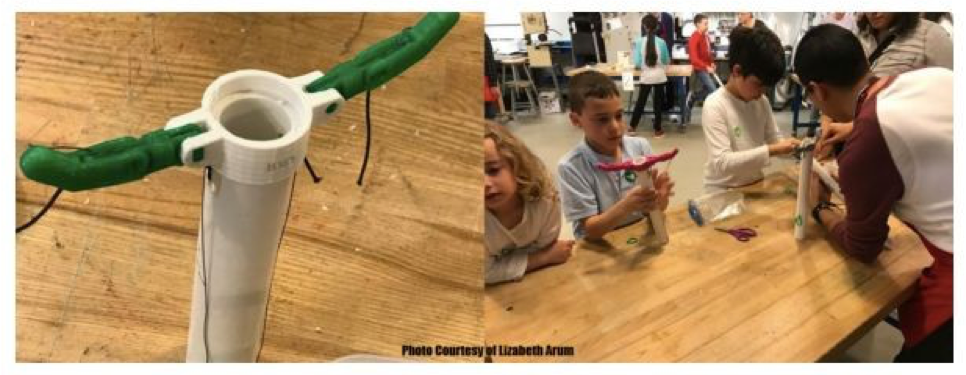This lesson will teach STEM and design concepts. It is adapted from an 8-module curriculum centering around the use of 3D printed prosthetics and other assistive devices. This curriculum is aimed at grades 7-10 and provides teachers with a mechanism for creating highly engaging and meaningful learning experiences for students through the creation, customization,and engineering of a tool intended to introduce 3D printed assistive devices.
Key Concepts
Forces
https://www.innerbody.com/image/musc04.html
https://sites.google.com/a/cpsdigital.org/peraplegic/human-prosthetics
Friction
https://www.ck12.org/physical-science/Types-of-Friction-in-Physical-Science/lesson/Types-of-Friction-MS-P S/
https://www.youtube.com/watch?v=9XtGJXVnQxk
Elastic Potential Energy
https://www.khanacademy.org/science/physics/work-and-energy/hookes-law/a/what-is-elastic-potential-ene rgy
https://www.youtube.com/watch?v=9LB6JeW39kU
Energy Transformations
https://science.howstuffworks.com/prosthetic-limb4.htm
https://sites.google.com/a/cpsdigital.org/peraplegic/human-prosthetics https://www.upperlimbprosthetics.info/index.php?p=1_9_Body-Powered
Materials Science https://sites.google.com/a/cpsdigital.org/peraplegic/human-prosthetics https://science.howstuffworks.com/prosthetic-limb2.htm https://www.explainthatstuff.com/prosthetic-artificial-limbs.html
https://3dprintingindustry.com/3d-printing-basics-free-beginners-guide/materials/
Hand Biology
https://www.ncbi.nlm.nih.gov/books/NBK279362/ https://www.youtube.com/watch?v=zyl6eoU-3Rg
Key Vocabulary
amputation: The removal of an appendage due to trauma, bacterial infection or life-threatening cause. A traumatic amputation occurs when an appendage is removed as a result of the trauma without medical care, such as a bomb.
amputee: A person with an amputation.
components: The internal working parts of a prosthesis.
composite: A material that is a combination of multiple material components, designed to have specific properties, such as carbon fiber.
constraints: In engineering design, the limitations and requirements that must be considered when designing a workable solution to a problem.
cosmetic prosthesis: A prosthesis that enhances a person’s appearance or completeness, but has no functional purpose. For example, a replacement glass eyeball is a cosmetic prosthesis if it does not also restore vision.
cover: As relates to prostheses, material used to cover a prosthesis to make it appear more lifelike. criteria: In engineering design, the objectives that a final design solution is required to meet.
functionality: As relates to prostheses, the ability of a prosthesis to have a purpose or reason for designing it in a specific way. For example, a wood peg leg has less functionality than a modern prosthetic leg that enables an athlete to run competitively.
interface: The point where a prosthetic device meets a residual limb.
prosthesis: An artificial device, either external or implanted, that replaces or supplements a missing or defective body part, such as a tooth, eye, facial bone, palate, hip, knee joint, leg, arm, hand, etc. May be designed for functional or cosmetic reasons or both. (plural: prostheses)
prosthetics: The surgical, dental and/or engineering specialty concerned with the design, fabrication and fitting of prostheses.
regenerate: (biology) To renew or restore a lost, removed or injured part. residual limb: The remaining portion of a body’s appendage or limb after amputation.
tissue engineering: The use of cells, and biochemical and physiochemical factors to design new biomaterials to replace lost or damaged body materials that have specific biological functions. transfemoral: A prosthesis that replaces the leg from above the knee (includes the knee, angle, foot and toes).
transhumeral: A prosthesis that replaces the arm from above the elbow (includes the elbow, wrist, hand and fingers).
transradial: A prosthesis that replaces the arm from below the elbow (includes the wrist, hand and fingers). transtibial: A prosthesis that replaces the leg from below the knee (includes the ankle, foot and toes). trauma: An event causing severe damage to the body.
Materials List
(see also lists below in each step)
Digital Fabrication Equipment Details
Hardware
Software
Design Files: https://drive.google.com/drive/folders/0B3tPBZnliO7bSkljT0otc1l0S28?usp=sharing
Map of the Lessons
Steps:
Step One: Define disability
Essential Question: What do you think of when you hear the word “disability?
Bell Ringer (10 Minutes): In a full class discussion, have students generate a list (or Wordle) of words that answer the question: What do you think of when you hear the word “disability?
Show the video “We’re the Superheroes” – Rio Paralympics Trailer
Return to the list – are there any terms we would like to add, change, remove, etc. Have any students changed their concept of the term “disability”?
Teacher Talk (25 Minutes): Share “Upper Limb Differences” powerpoint with students
On Smartboard show the following videos:
In-class writing (20 Minutes): Using “Next Generation Assistive Devices” jigsaw activity – Have students write short responses (ungraded) on their preconceptions about disability and track their understanding of concepts.
Step Two: Science behind prosthetic performance
Essential Question: What are the areas of science that affect prosthetic performance?
Elastic Potential Energy
https://www.khanacademy.org/science/physics/work-and-nergy/hookes-law/a/what-is-elastic-potential-energy
https://www.youtube.com/watch?v=9LB6JeW39kU
Energy Transformations
https://science.howstuffworks.com/prosthetic-limb4.htm
https://sites.google.com/a/cpsdigital.org/peraplegic/human-prosthetics https://www.upperlimbprosthetics.info/index.php?p=1_9_Body-Powered
Materials science https://sites.google.com/a/cpsdigital.org/peraplegic/human-prosthetics https://science.howstuffworks.com/prosthetic-limb2.htm https://www.explainthatstuff.com/prosthetic-artificial-limbs.html
https://3dprintingindustry.com/3d-printing-basics-free-beginners-guide/materials/
Hand biology
https://www.ncbi.nlm.nih.gov/books/NBK279362/ https://www.youtube.com/watch?v=zyl6eoU-3Rg
Pre-assessment of student understanding based on responses on the know/want-to-know/learned (KWL) Chart
K: What do I know about 3D Printed Assistive Devices? W: What do I want to find out?
L: What have I learned?
Step Three: Understand a Design Process
Essential Question: What is the Design Process?

Step Four: Hack a Raptor
TEACHER NOTES:
Step Five: Create Design Files for Knuckles & Fingers (40 Minutes)
A. Knuckle Ring
Step Six: Build the Grab-tor (Grabbing Raptor)
Step Seven: “Animalize” your Grab-tor
TEACHER NOTE: Following design of “Animalized” Grab-Tor, teachers will need to decide on the printing schedule and construction of the devices
BELL RINGER: Show 10 Amazing Animal Predators or Bird Feeding Adaptations and discuss natural selection of claws, beaks, jaws, and talons
Having trouble? Let us know by completing the form below. We'll do our best to get your issues resolved quickly.
"*" indicates required fields
Thank you for your fab contribution!